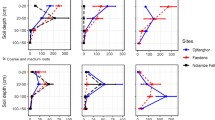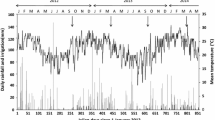Abstract
Root morphology of 5-year-old trees of Dacryodes edulis (G. Don) H. J. Lam of seed and two vegetative (cutting and marcot) origins were assessed in Cameroon. Roots of D. edulis trees of seed and vegetative origins were totally excavated and their root morphology described and quantified. Trees of seed origin were characterized by a tap root, reaching depths of about 1.2 m. Contrarily trees of cutting origin showed three strong vertical roots (d > 5 mm) with the longest reaching depths of 1.31 m. Trees of marcot origin were observed to have thick, relatively short prominent vertical roots, reaching depths of 1.15 m. At fixed lateral intra-row distances of 50 cm from tree bases, trees of seed and marcot origins recorded high root densities at soil depths of 0–20 cm; both differed significantly (p = 0.032) from those of trees of cutting origin. At soil depth of 60–100 cm, trees of cutting origin recorded the highest root density which however differ significantly (p = 0.016) from those of trees of both seed and marcot origins. D. edulis trees of seed origin had a tap root system, whereas trees of vegetative origin (cuttings and marcots) had developed prominent main adventitious roots growing vertically (sinker roots), into greater depths and a wider/deeper lateral root spread than seedlings. This could be a vital adaptation to the absence of a genetically determined tap roots in trees of vegetative origins so as not to compromise the acquisition of soil-based resources (water and dissolved ions) and anchorage.





Similar content being viewed by others
References
Akinnifesi F, Kang BT, Ladipo DO (1999) Structural root form and fine root distribution of some woody species evaluated for agroforestry systems. Agrofor Syst 42:121–138
Ambassa-Kiki R (2002) Caractérisation Biophysique Succincte des différentes Zones Agroécologiques du Cameroun. IRAD, Yaoundé, Cameroun
Ayuk ET, Duguma B, Franzel S, Kengue J, Mollet M, Tiki-Manga T, Zekeng P (1999) Uses, management and economic potential of Dacryodes edulis (Burseraceae) in the humid lowlands of Cameroon. Econ Bot 53(3):292–301
Bohm W (1979) Methods of studying root systems. Ecological studies 33. Springer, Berlin, pp 188
Chaturvedi OP, Das DK (2003) Studies on the rooting pattern of 5-year-old important agroforestry tree species grown in the North Bihar, India. Forest, Trees and People 40:89–100
Coutts MP (1983a) Root architecture and tree stability. Plant Soil 71:171–188
Coutts MP (1983b) Development of the structural root system of Sitka spruce. Forestry 56:1–16
Eis S (1974) Root system morphology of western hemlock, western red cedar and Douglas-fir. Can J For Res 4:28–38
FAO (1991). Digitized soil map of the world. Vol 1 Africa. Release 1.0, November 1991. World soil resources report 67/1. FAO, Land and Water Development Division, Rome, Italy
Fayle DCF (1975a) Extension and longitudinal growth during the development of red pine root systems. Can J For Res 5:109–121
Fayle DCF (1975b) Distribution of radial growth during the development of red pine root systems. Can J For Res 5:608–625
GenStat (2002) GenStat Procedure Library Release PL14, 8th edn. Lawes Agricultural Trust, Rothamsted experimental station
Hartmann HT, Kester DA, Davies FT Jr, Geneve RL (2002) Plant propagation: principles and practices, 7th edn. Pearson Education, New Jersey
Huxley PA (1983). Some characteristics of trees to be considered in agroforestry. In: Huxley PA (ed) Plant research and agroforestry, pp 3–12. ICRAF, Nairobi, Kenya
Jamaludheed V, Kumar BM, Wahid PA, Kamalan NV (1997) Root distribution pattern of wild jack tree (Artocarpus hirsutus Lamk.) as studied by 32P soil injection method. Agrofor Syst 35:329–336
Kengue J (2002) Fruits for the future 3: Safou (Dacryodes edulis. G. Don). International Centre for Underutilised Crops, Southampton, UK
Kengue J, Tchio F (1994). Essais de bouturage et de marcottage du Safouier (Dacryodes edulis). In: Kengue J, Nya Ngatchou J (eds). Le safoutier (Dacryodes edulis) Acte du Seminaire Regional sur la Valorisation du Safoutier. 4–6 October 1994, Douala, Cameroun, pp 80–98
Köstler JN, Brückner E, Bibelriether H (1968) Die Wurzeln der Waldbäume. Paul Parey, Hamburg
Krasilnikov PK (1968) On the classification of the root systems of trees and shrubs. In: The methods of productivity studies in the root systems and rhizosphere organisms. Nauka (USSR Academy of Sciences), Moscow, pp 106–114
Lynch J, Nielsen KL (1996) Simulation of root system architecture. In: Waisel Y, Eshel A, Kafkafi U (eds) Plant roots: the hidden half. Marcel Dekker, New York, pp 247–271
Mampouya P, Galamo G, Mialoundama F (1994) Recherche de nouveaux substrats et influence des regulateurs de croissance sur le marcottage aerien du safoutier (Dacryodes edulis G. Don Lam). In: Kengue J, Nya Ngatchou J (eds) Le Safoutier, the african pear. Acte du Seminaire Regional sur la Valorisation du Safoutier. 4–6 October 1994, Douala, Cameroun, pp 72–79
Mialoundama F, Avana M-L, Youmbi E, Mampouya PC, Tchoundjeu Z, Mbeuyo M, Galamo GR, Bell JM, Kopguep F, Tsobeng AC, Abega J (2002) Vegetative propagation of Dacryodes edulis (G.Don) H.J. Lam by marcots, cuttings and micropropagation. Forest Trees Livelihoods 12:85–96
Nielsen CCN (1990) Einflüsse von Pflanzenabstand und Stammzahlhaltung auf Wurzelform, Wurzelbiomasse, Verankerung sowie auf die Biomassenverteilung im Hinblick auf die Sturmfestigkeit der Fichte. University of Göttingen Faculty of Forestry and Niedersächsischen Forstlichen Versuchsanstalt, Thesis 100, J D Sauerländer’s Verlag, Frankfurt am Main, pp 279
Nielsen CCN (1991) Zur verankerungsökologie der Fichte. Forst und Holz 46:178–182
Pomerleau R, Lotie N (1962) Relationships of dieback to the rooting depth of white birch. For Sci 8:219–224
Rao MR, Muraya P, Huxley PA (1993) Observations of some tree root systems in agroforestry intercrop situation, and their graphical representation. Exp Agric 29:183–194
Salas E, Ozier-Lafontaine H, Nygren P (2004) A fractal root model applied for estimating the root biomass and architecture in two tropical legume tree species. Ann For Sci 61:337–345
Simon A, Mngomba Akinnifesi FK, Sileshi G, Ajayi OC, Chakeredza C, Weston F, Mwase WF (2008) A decision support tool for propagating Miombo indigenous fruit trees of southern Africa. Afr J Biotechnol 7(25):4677–4686
Toky OP, Bisht RP (1992) Observations on the rooting patterns of some agroforestry trees in an arid region of North-Western India. Agrofor Syst 18:245–263
Toky OP, Kuma P, Khosla PK (1989) Structure and function of traditional agroforestry systems in the Western Himalaya. Biomass and productivity. Agrofor Syst 9:47–70
Van Noordwijk M, Purnomosidhi (1995) Root architecture in relation to tree–soil–crop interactions and shoot pruning in agroforestry. Agrofor Syst 30:161–173
Vogt KA, Persson H (1991) Measuring growth and development of roots. In: Lassoie JP, Hinckley TM (eds) Techniques and approaches in the forest tree ecophysiology. CRC Press, Boca Raton, FL, pp 477–501
Von Maydell HJ (1987) Agroforestry in the dry zone of Africa: past, present and future. In: Steppler HA, Nair PKR (eds) Agroforestry: a decade of development. ICRAF, Nairobi, pp 89–116
Weaver JE (1958) Classification of the root systems of forms of grassland and a consideration of their significance. Ecology 39:393–401
Zimmerman MH, Brown CL (1971) Trees: structure and function. Springer, New York
Zobel RW (1996) Genetic control of root systems. In: Waisel Y, Eshel A, Kafkafi U (eds) Plant roots—the hidden half, 2nd edn. Marcel Dekker, New York
Author information
Authors and Affiliations
Corresponding author
Additional information
Communicated by R. Hampp.
Rights and permissions
About this article
Cite this article
Asaah, E.K., Tchoundjeu, Z., Wanduku, T.N. et al. Understanding structural roots system of 5-year-old African plum tree (D. edulis) of seed and vegetative origins (G. Don) H. J. Lam. Trees 24, 789–796 (2010). https://doi.org/10.1007/s00468-010-0449-2
Received:
Revised:
Accepted:
Published:
Issue Date:
DOI: https://doi.org/10.1007/s00468-010-0449-2




